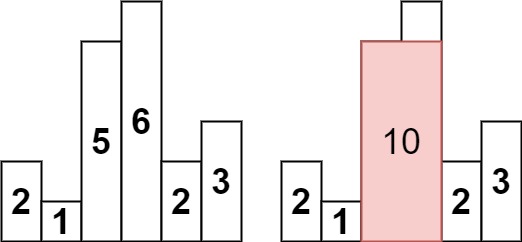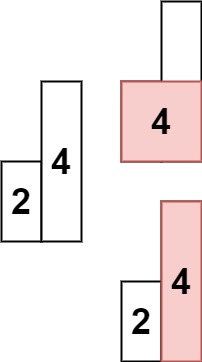Largest Rectangle in Histogram
Given an array of integers heights representing the histogram's bar height where the width of each bar is 1, return the area of the largest rectangle in the histogram.
Example 1:

Input: heights = [2,1,5,6,2,3] Output: 10 Explanation: The above is a histogram where width of each bar is 1. The largest rectangle is shown in the red area, which has an area = 10 units.
Example 2:

Input: heights = [2,4] Output: 4
Constraints:
1 <= heights.length <= 1050 <= heights[i] <= 104
class Solution:
def largestRectangleArea(self, heights: List[int]) -> int:
n = len(heights)
next_lowest = [n for i in range(n)]
prev_lowest = [-1 for i in range(n)]
maxArea = 0
inc_stack = []
for i in range(n):
while len(inc_stack) > 0 and heights[i] < heights[inc_stack[-1]]:
curr = inc_stack.pop()
next_lowest[curr] = i
if len(inc_stack) > 0:
prev_lowest[i] = inc_stack[-1]
inc_stack.append(i)
for i in range(n):
currArea = (next_lowest[i] - prev_lowest[i] - 1) * heights[i]
maxArea = max(maxArea, currArea)
return maxArea
# class Solution:
# def largestRectangleArea(self, heights: List[int]) -> int:
# n = len(heights)
# maxArea = 0
# for i in range(n):
# curr = heights[i]
# left = i
# right = i
# while left >= 0 and heights[left] >= curr:
# left -= 1
# left += 1
# while right < n and heights[right] >= curr:
# right += 1
# right -= 1
# maxArea = max(maxArea, curr * (right - left + 1))
# return maxArea
# class Solution:
# def makeSeg(self, arr, i, j):
# if (i, j) in self.seg:
# return self.seg[(i, j)]
# if i == j:
# self.seg[(i, j)] = arr[i]
# return arr[i]
# mid = (i + j) // 2
# curr = min(self.makeSeg(arr, i, mid), self.makeSeg(arr, mid + 1, j))
# self.seg[(i, j)] = curr
# return curr
# def getMin(self, arr, i, j, ni, nj):
# if ni >= i and nj <= j:
# return self.seg[(ni, nj)]
# if (ni < i and nj < i) or (ni > j and nj > j):
# return float('inf')
# mid = (ni + nj) // 2
# return min(self.getMin(arr, i, j, ni, mid), self.getMin(arr, i, j, mid + 1, nj))
# def largestRectangleArea(self, heights: List[int]) -> int:
# self.seg = {}
# n = len(heights)
# if n == 1:
# return heights[0]
# self.makeSeg(heights, 0, n - 1)
# mrec = float('-inf')
# for i in range(n):
# for j in range(i, n):
# mrec = max(mrec, (j - i + 1) * self.getMin(heights, i, j, 0, n - 1))
# return mrec
# class Solution:
# def largestRectangleArea(self, heights: List[int]) -> int:
# n = len(heights)
# areas = []
# maxArea = float('-inf')
# areas.append((0, heights[0]))
# for i in range(1, n):
# if heights[i] < areas[-1][1]:
# maxArea = max(maxArea, (i - areas[-1][0]) * areas[-1][1])
# areas.pop()
# areas.append((i, heights[i]))
# return maxArea
Comments
Post a Comment